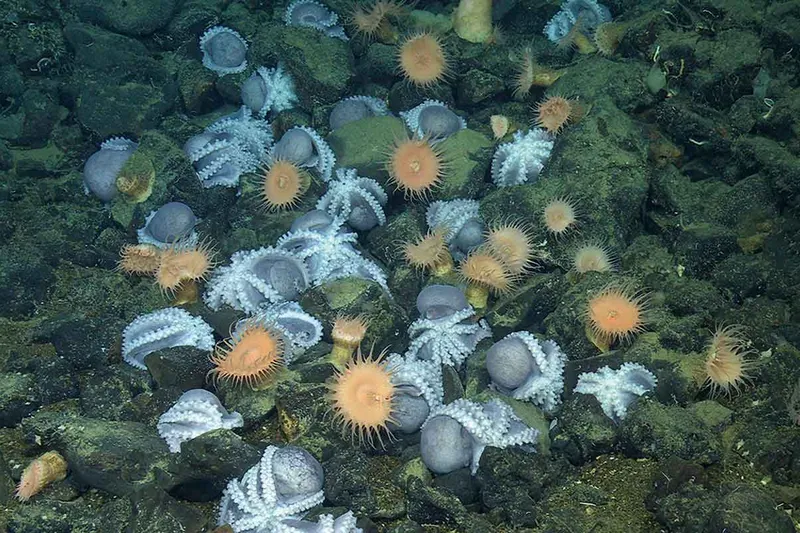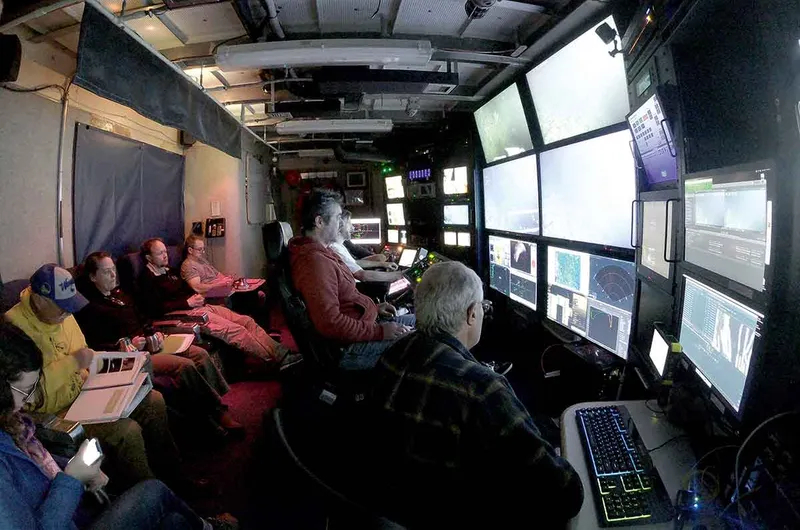A mauve arm, covered in suckers, gently unfurls and tends to a clutch of eggs shaped like elongated ping pong balls. Puffs of water from the siphon on the side of the octopus’s head ensure her unhatched young get plenty of oxygen.
She’s surrounded by hundreds of other females which, when viewed from a distance, live up to their nickname. Pearl octopuses (Muusoctopus robustus) resemble spherical gems sitting on the seabed. This is the largest known aggregation of eight-armed molluscs on the planet – around 20,000 – and it was witnessed by people all around the world in stunning high definition in the ‘Oceans’ episode of the BBC series Planet Earth III.
This view would have been astonishing enough had it come from somewhere in the shallow seas, a tropical coral reef or a kelp forest, but these octopus mothers are tending their eggs almost 3km (2 miles) below the surface, in the freezing cold and darkness of the deep sea.
“The fact life is there at all is amazing,” says producer and director Will Ridgeon who spent two years filming the octopuses and collaborating with scientists and engineers at the Monterey Bay Aquarium Research Institute (MBARI) in California.

The Octopus Garden, as the site is now known, is located in the eastern Pacific, 160km (100 miles) southwest of Monterey Bay, on a hillock near a giant underwater mountain called Davidson Seamount. The site was discovered in 2018 during an expedition that was being live-streamed over the internet.
It was the first time anyone had seen so many of these creatures in one place, let alone in the deep sea (octopuses are notoriously solitary animals and when kept together in captivity they tend to become cannibalistic).
Ridgeon was watching the live stream of the discovery and immediately knew this was a story to film for the new BBC series. He teamed up with Dr Jim Barry, senior scientist at MBARI, who started making regular visits to the Octopus Garden in 2019 to learn more about why so many octopuses congregate in that particular spot.
“The question was, why there?” says Barry. Barry and his colleagues brought together specialised tools to launch a series of detailed studies. They created a photomosaic of a 2.5-hectare (almost 27,000ft2 ) portion of the site, stitching together high-resolution images that let them count individual octopuses.
They also set up time-lapse cameras on the seabed, which snapped close-up pictures every 20 minutes for months at a time, to show what the octopuses were up to and gradually, Barry’s team began solving some of the Octopus Garden’s biggest mysteries.

Working remotely
Ridgeon got involved in the expeditions to the Octopus Garden early on. At first, the shoots took place during lockdown, so he joined via live video link from his bedroom in Bristol, UK (occasionally interrupted by his five-year-old daughter).
When COVID-19 restrictions allowed, Ridgeon joined Barry and his team on MBARI’s ship, the research vessel Western Flyer. But none of them visited the Octopus Garden in person. All the research and filming was done using a car-sized remote-operated vehicle, or ROV, equipped with cameras and robotic arms.
The dives started around 6am, when the ROV was lowered into the sea through a hole in the Western Flyer’s hull called a moon pool. “It’s quite James Bond,” says Ridgeon. The descent to the Octopus Garden can take up to two hours and the ROV stays down there for the entire day.
Pilots control the ROV via a cable linking it to a control room on the ship at the surface, where everyone watches the video feed to see what’s going on below.

“You forget you’re looking at screens,” says Ridgeon. “You think you’re down there.” Engineers at MBARI worked with the BBC to find the ideal camera set-up to film the Octopus Garden. It wasn’t possible to use footage from cameras fixed to the ROV, because there’s too much vibration.
“The BBC can take care of a little bit of that [shivering],” says Barry, “but not as much as we had.” The ROV ‘shivers’ not because of the cold temperatures in the deep, but because its thrusters have to run constantly to ensure it stays down near the seabed (the ROV is positively buoyant, so it will float back to the surface if it malfunctions).
To get around that, Barry and Ridgeon used a separate 4K camera on a specially designed stand that they could place on the seabed.
“That was the secret, I think, behind the images,” says Ridgeon. Unlike the cameras on the ROV that the scientists use, which can only get within a couple of metres of a subject on the seabed, the 4K camera has a focal length of around 20cm (7-8in) and could get right among the octopuses.
But it was difficult to use. It took up to 40 minutes to position, then the team had to hope it wouldn’t fall over and that the action would take place in front of it. Ridgeon operated the camera from the ship, using a PlayStation controller MBARI engineers had adapted for the task. “It’s like trying to film with your hands tied behind your back, at first,” says Ridgeon.
Another challenge of filming in the deep sea is light. “You want to get your lights as far away from the camera as possible and ideally around the side so you can three-quarter backlight [the scene], so you don’t get reflection off all the bits and pieces in the water,” Ridgeon explains.

Those “bits and pieces” are marine snow – organic particles that constantly fall from shallower seas above. Marine snow is made of dead plankton and their faeces, stuck together with a microbial glue, and it’s the main source of food for animals in the deep sea. But it makes filming difficult because films can look like they were shot in a blizzard.
To see through the blizzard and achieve the desired three-quarter backlight effect, the MBARI team built a lighting rig that the ROV could hold away from the camera and off to the side. “That’s how we got some of these really fantastic shots,” says Barry.
Read more:
- Octopuses: playful, choosy and smarter than you think
- What is the difference between a squid and an octopus?
Accelerated development
As Barry’s research and the BBC’s filming progressed, the team made some startling discoveries. For one thing, there were never any medium-sized octopuses coming to the site, nor any signs of feeding. It was only ever fully grown, mature octopuses.
They were coming here to reproduce and nothing else. It might be called the Octopus Garden, but the site is undoubtedly an octopus nursery. The team also gathered evidence that the brooding females are using thermal springs at the site to speed up the development of their young.
For octopuses, there’s a strong relationship between temperature and hatching time; the colder it is, the longer it takes and the more dangerous it becomes because there are scavengers waiting to feast on unborn, unguarded octopus eggs.
Temperature probes showed that the seawater surrounding each octopus nest could reach 10°C (50°F), far warmer than the 1.6°C (34°F) of the water just a few metres away. By watching specific octopuses brooding at the site (individuals are recognisable by their patterns of scratches and scars), Barry and colleagues saw that their eggs take 1.8 years on average to hatch.
The females don’t move during that time but are constantly batting away predators and safeguarding their clutch of around 60 eggs. “Once you plant your eggs on the rock, that’s it – you’re stuck with that site,” says Barry. At just under two years, it’s not the longest octopus brood time. That record goes to Graneledone boreopacifica, a different species that other MBARI scientists found nearby, clinging to the side of Monterey Canyon at a depth of 1.4km (just under a mile).
They saw one female brooding her eggs for 4.5 years – longer than any other animal on record. But she was rearing her eggs in the water much warmer than the 1.6°C ambient temperature at the Octopus Garden. If it weren’t for the thermal springs, it would likely take a decade or more for the Octopus Garden eggs to hatch. When the site was discovered, biologists were astounded to find octopuses nesting there.
Geologists, however, were fascinated by the warm water percolating up through the seabed, which had never been seen before. The springs are much cooler than the searing hydrothermal vents that form at the edges of tectonic plates where new, molten seafloor is made.
Temperatures around vents can be hundreds of degrees, although the immense pressure prevents the water from boiling. They were first discovered in the 1970s and are relatively easy to detect with temperature probes, because plumes of hot water rise hundreds of metres up the water column. In contrast, thermal springs form away from these tectonically vigorous regions and, being much cooler, are more difficult to find.
But geologists think there could be thousands of them and that they’re likely to be highly stable, persisting in the same spot for hundreds, even thousands, of years. As such, biologists think there could be lots more octopus nurseries out there, established around these springs.
Births and deaths
In the final scene of the ‘Octopus Garden’ episode of Planet Earth III, a cluster of tiny, suckered arms appears below a brooding female, then a bobble-headed young octopus swims off, like a mini-umbrella, into the darkness. More hatchlings follow and begin their lives in the ocean.
Where they go, nobody knows… yet. “That’s the next thing that I’d love to figure out,” says Barry. The hatchlings are big for octopus newborns, around 6cm (2in), giving them the best possible chance of surviving. But as anyone who’s watched an octopus documentary before knows, this comes at an immense cost to the mothers.
“These mums are fierce defenders of their brood, while they’re just withering away,” says Barry. The fathers died years earlier, shortly after mating. On-screen, we see the females’ eyes glaze over and their bodies become wrinkled. Ridgeon saw what happens next, but decided it wasn’t suitable for early evening TV audiences.
The octopuses’ corpses are immediately set upon by scavenging fish, snails, sea anemones and shrimp For Barry, this is another critical part of his findings at the Octopus Garden. The nesting season is asynchronous, with octopuses hatching and mothers dying throughout the year – roughly nine every day. The bodies of female octopuses help feed the rest of the ecosystem, supplementing the input of energy from marine snow by 72 per cent.

“It’s clearly a big food subsidy for the local ecosystem,” says Barry. “It wouldn’t be if it was in shallow water,” he adds, because there’s plenty of food around. But in the more barren deep sea, nothing goes to waste.
The BBC has finished filming at the Octopus Garden, but Barry’s studies continue. One thing he’s keen to know is how old the sea anemones are. These are the giant orange, flower-like animals that make the Octopus Garden look like a real garden.
Barry has studied sea anemones that live for decades in the shallow coastal waters and suspects the deep-sea varieties could live for centuries, in stark contrast to the relatively short-lived octopuses.
“They’re like these sentinels that have just been sitting there while the octopuses are cycling through,” he says. There are plenty more questions Barry would like answers to. “Are the octopuses locked into this form of breeding in warm sites, or can they still breed elsewhere at cooler, ambient temperatures? Is there fidelity to a particular nest site? Do they come back to the site they were born?” he asks.
Nobody knows how far the octopuses travel to reach the garden, or how they find it, although Barry suspects they smell the scent wafting from so many dead and dying octopuses. “We’ll definitely keep going back,” he says.
Read more: